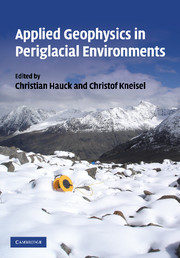Book contents
- Frontmatter
- Contents
- List of contributors
- Introduction
- Part I Geophysical methods
- Part II Case studies
- 5 Typology of vertical electrical soundings for permafrost/ground ice investigation in the forefields of small alpine glaciers
- 6 ERT imaging for frozen ground detection
- 7 Electrical resistivity values of frozen soil from VES and TEM field observations and laboratory experiments
- 8 Results of geophysical surveys on Kasprowy Wierch, the Tatra Mountains, Poland
- 9 Reassessment of DC resistivity in rock glaciers by comparing with P-wave velocity: a case study in the Swiss Alps
- 10 Quantifying the ice content in low-altitude scree slopes using geophysical methods
- 11 The use of GPR in determining talus thickness and talus structure
- 12 GPR soundings of rock glaciers on Svalbard
- 13 Arctic glaciers and ground-penetrating radar. Case study: Stagnation Glacier, Bylot Island, Canada
- 14 Mapping of subglacial topography using GPR for determining subglacial hydraulic conditions
- 15 Snow measurements using GPR: example from Amundsenisen, Svalbard
- 16 Mapping frazil ice conditions in rivers using ground penetrating radar
- Appendix: Tables of geophysical parameters for periglacial environments
- Index
- Plate section
- References
8 - Results of geophysical surveys on Kasprowy Wierch, the Tatra Mountains, Poland
Published online by Cambridge University Press: 22 August 2009
- Frontmatter
- Contents
- List of contributors
- Introduction
- Part I Geophysical methods
- Part II Case studies
- 5 Typology of vertical electrical soundings for permafrost/ground ice investigation in the forefields of small alpine glaciers
- 6 ERT imaging for frozen ground detection
- 7 Electrical resistivity values of frozen soil from VES and TEM field observations and laboratory experiments
- 8 Results of geophysical surveys on Kasprowy Wierch, the Tatra Mountains, Poland
- 9 Reassessment of DC resistivity in rock glaciers by comparing with P-wave velocity: a case study in the Swiss Alps
- 10 Quantifying the ice content in low-altitude scree slopes using geophysical methods
- 11 The use of GPR in determining talus thickness and talus structure
- 12 GPR soundings of rock glaciers on Svalbard
- 13 Arctic glaciers and ground-penetrating radar. Case study: Stagnation Glacier, Bylot Island, Canada
- 14 Mapping of subglacial topography using GPR for determining subglacial hydraulic conditions
- 15 Snow measurements using GPR: example from Amundsenisen, Svalbard
- 16 Mapping frazil ice conditions in rivers using ground penetrating radar
- Appendix: Tables of geophysical parameters for periglacial environments
- Index
- Plate section
- References
Summary
Introduction
Geophysical surveys are more and more commonly used for the investigation of both permafrost features and their changes in high mountain environments. Before the rebuilding of the cable railway on Kasprowy Wierch, Tatra Mountains, Poland, geophysical techniques were applied to determine the ground conditions of the planned construction site. The survey results were used to prepare a geotechnical expert report for the reconstruction of the upper section of the cable railway. This contribution aims to show the possibilities, limitations and ways of interpreting the geophysical measurements obtained in a mountainous periglacial environment within the zone of discontinuous permafrost.
Field site
Kasprowy Wierch is a peak in the main ridge of the Tatra Mountains (Figure 8.1), 1986 m a.s.l. It consists of granodiorite and pegmatites, which form a tectonic cap-rock on the summit with a thickness of a few hundred metres (Bac-Moszaszwili and Gąsienica-Szostak1990). Faults and fractures can be seen in the dome. Although the area of the Tatra Mountains was glaciated several times (Gadek 1998), the peak was transformed by periglacial processes only (Klimaszewski 1988), which led to the creation of block fields on the dome. The thickness of the weathered material reaches 3–4 m (Gryczmanski et al. 2004). In contrast to the peak, all adjacent valleys were glaciated. Distinct glacial undercutting rock faces are visible on the northern part of the peak (Figure 8.2). Kasprowy Wierch is the only mountain in the Polish Tatra Mountains so extensively used by people.
- Type
- Chapter
- Information
- Applied Geophysics in Periglacial Environments , pp. 126 - 136Publisher: Cambridge University PressPrint publication year: 2008
References
- 3
- Cited by



